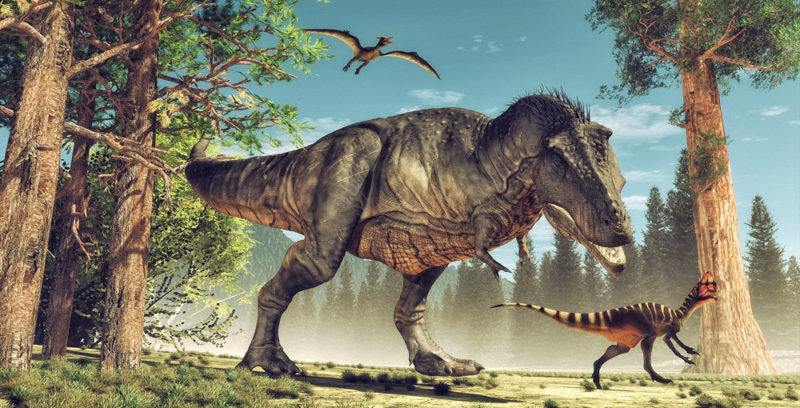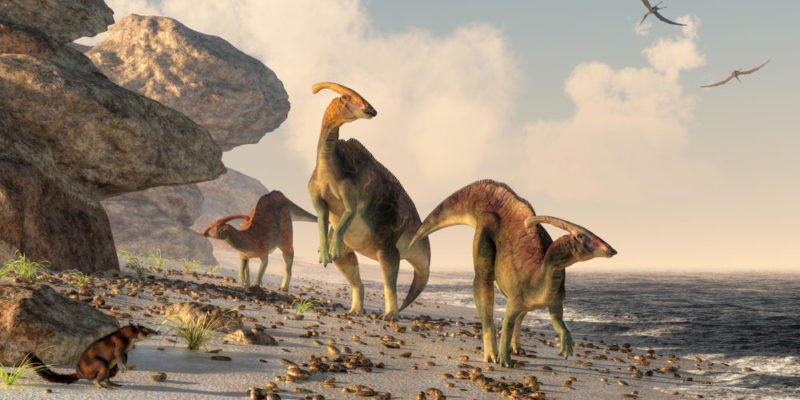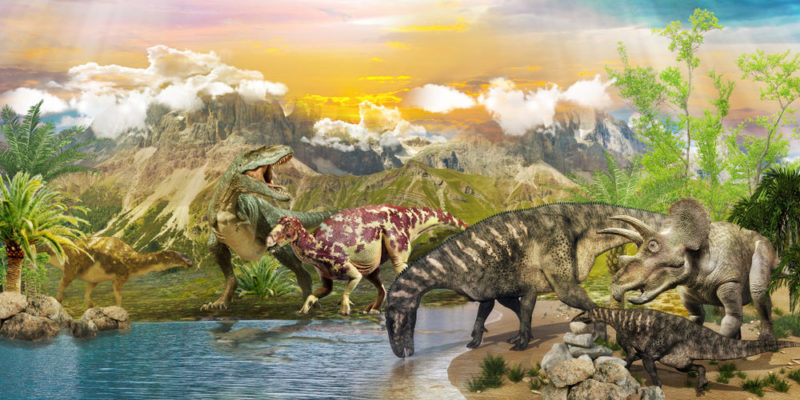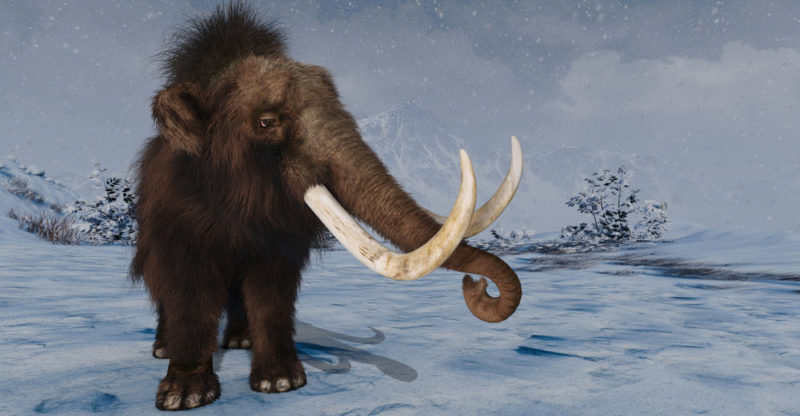We explain what the Cretaceous Period was and how it is divided. Also, what are its characteristics and why is it so important.
What was the Cretaceous Period?
It is known as the Cretaceous Period or simply Cretaceous, the period of the geological time scale that culminates the Mesozoic Era (which began 252.2 million years ago and ended 66 million years ago). It is the third after the Triassic (initial period) and Jurassic (intermediate period) periods.
The Cretaceous began 145 million years ago and ended approximately 66.4 million years ago. It is a particularly long period, longer even than the Cenozoic era that follows it.
Its culminating moment, which is also the culmination of the entire Mesozoic Era, is determined by the so-called K/Pg Event, which is suspected to have consisted of the fall of a gigantic meteorite in the Yucatan Peninsula . It opened a huge crater and caused the extinction of the dinosaurs , among many other species.
Previous period
The Jurassic Period began 201 million years ago and ended 145 million years ago.
It was the period in which the dinosaurs proliferated and reigned , which is why it is perhaps the most famous of the Mesozoic periods.
In this period , the fracture of the Pangea Supercontinent began . The great dinosaurs conquered the land , the sea and even the air .
Cretaceous Period Division

Despite being so extensive, the Cretaceous Period is divided into two Epochs or Series, each one comprised of six Ages or Floors:
- Early or Lower Cretaceous. It begins after the end of the Jurassic, approximately 145 million years ago, and extends until about 113 million years ago. It includes the Berriasian, Valanginian, Hauterivian, Barremian, Aptian and Albian ages.
- Late or Upper Cretaceous. It begins about 100.5 million years ago and lasts until about 72 million years ago. It includes the Cenomanian, Turonian, Coniacian, Santonian, Campanian and Maastrichtian ages.
Geological characteristics of the Cretaceous
During the Cretaceous there was a significant increase in the level of the waters , which at its maximum point left out only 18% of the planet 's surface . On the other hand, important mountain ranges such as the North American mountain range , the Andes and the Himalayas originated.
The division of the Pangea supercontinent that began in the Jurassic was accentuated throughout the Cretaceous. At the beginning of the period, only two continents were distinguished : Laurasia and Gondwana, separated by the Tethys Sea. But in a slow process, the shape and position of the current continents were modelled.
However, towards the end of the period, the new arrangement of the continents identified twelve separate portions of land, as rising waters had created new seas , flooding once desert plains.
Climatic characteristics of the Cretaceous

The global temperature rise peaked 100 million years ago . As a consequence, there was practically no ice at the poles and the world was submerged.
Ocean water temperatures were 9-12°C warmer than today, at least in the tropics. In the deep ocean temperatures could be even 15 to 20 °C higher.
The planet's climatic uniformity led to a stagnation in ocean currents and planetary winds, which would have produced oceans much calmer than today.
Characteristics of the Cretaceous flora
In the Early Cretaceous, a revolutionary event took place in the botanical world: angiosperms, that is, plants with flowers, seeds and fruits, appeared . And their evolutionary success was such that in just 20 million years the pollen levels of these plants increased from 1% to 40%.
In the Late Cretaceous there were already 50 of the 500 known modern families , such as beech, fig, birch, holly, magnolia, oak, palm, sycamore, walnut, and willow.
The work of the insects was key in the pollination processes and the plants must have attracted them, through sweet secretions and striking colors. The first bee from the Cretaceous, for example, was discovered in 2006 preserved in amber in Burma. That is why it can be said that insects and angiosperms co-evolved.
The same thing happened with gymnosperm plants, the favorite food of large herbivorous dinosaurs, which developed spines, unpleasant tastes and other defense mechanisms to prevent them from eating their upper portions, where they received more sun . This evolutionary pressure resulted in an enormous diversification of plant species .
Characteristics of the Cretaceous fauna

Life in the Cretaceous had reached significant levels of diversification, the result of the competition that began in the Jurassic. However, the seas remained the largest reservoir of animal life .
There were species of ammonites, fish of various sizes , and large aquatic reptiles , such as elasmosaurids (plesiosaurs with very long necks), mosasaurs, both fierce predators . The first turtles , the first rays, and the first sharks also made their appearance, replacing the extinct ichthyosaurs.
The transformation of the winged dinosaurs into birds continued , stripping them of teeth and hollowing out their bones, although increasing in size. Mammals , for their part, remained a small, unimportant and minor group of fauna, although much more diverse than before.
Finally, the world belonged to the dinosaurs , some of which are now very famous in the modern imagination, such as the Ornithopods (Iguanodon, Hypsilophodon, Hadrosaurs, Ceratopsids and Pachycephalosaurs).
In addition, there were the Theropods, large terrestrial predators such as the famous Tyrannosarus Rex , or the Carnotaurus and the Spinosaurus; or also the ferocious Raptors ( Velociraptor and Deinonychus ). There were more species of dinosaurs in the Cretaceous than at any other time, but of all of them only the birds survived.
Mass extinction or KT or K/Pg event

KT Event (Cretaceous-Tertiary) or K/Pg (Cretaceous-Paleogene) is called the inexplicable mass extinction of animal and plant species at the end of the Cretaceous Period.
In this event , all the dinosaurs , from land and sea, and a large part of other different species, became extinct in a rapid and violent manner. However, it was not the largest mass extinction recorded in the geological history of the planet.
It is known that a good part of the smaller terrestrial reptiles (salamanders, turtles, snakes , crocodiles ), insects, amphibians and placental mammals survived, as well as a good part of the invertebrate marine inhabitants.
Different hypotheses about its cause are handled:
- climatic events . Since the affected population was mostly tropical, leaving the high-latitude population relatively untouched, it can be assumed that some kind of climatic catastrophe would have occurred as a result of the continental plates moving apart.
- Impact of a meteorite . Perhaps the most accepted theory, proposed by Luis Álvarez and Walter Álvarez, deduces from the abundant iridium found in the Cretaceous sediments, that the extinction could have been caused by the impact of a meteorite in Yucatán, Mexico , since said metal it's rare on the planet. This meteor would have raised a layer of dust in the atmosphere , causing an unexpected global winter.
- extraterrestrial causes. There are various theories that accuse the extinction of extra-planetary causes, such as nearby supernovae or solar phenomena that dramatically changed the amount of radiation received by the planet.
Formation of oil fields
Another important feature is that in the Cretaceous the material was formed that later constituted the large oil reserves of the entire world, more than 50% of what we know today. Especially the reserves of the Persian Gulf, the Gulf of Mexico and the coasts of Venezuela were formed throughout this period.
Importance of the end of the dinosaurs

The disappearance of the dinosaurs is an event that has intrigued humanity ever since we discovered and confirmed their presence, based on the huge fossils discovered.
On the one hand, we do not know the exact cause of the disappearance of almost 75% of the life existing on the planet at that time. On the other hand, their disappearance allowed the rise and flourish of mammals , among which are our direct evolutionary ancestors.
Without the mass extinction of KT, it is possible that humanity would never have been able to exist , since the world would have continued to be ruled by those ferocious and mammoth creatures.
The Cenozoic era
After the end of the Cretaceous, the Mesozoic Era closes and the Cenozoic Era opens, formerly known as the Tertiary. Significant cooling of the planet occurred which then led to future ice ages.
As the etymology of its name indicates (from the Greek kainos , “new”, and zoe , “animal”), it was a period in which new forms of life appeared and proliferated on the planet.
The above content published at Collaborative Research Group is for informational and educational purposes only and has been developed by referring reliable sources and recommendations from technology experts. We do not have any contact with official entities nor do we intend to replace the information that they emit.
Veronica is a culture reporter at Collaborative Research Group, where she writes about food, fitness, weird stuff on the internet, and, well, just about anything else. She has also covered technology news and has a penchant for smartphone stories. .
Leave a reply
Your email address will not be published. Required fields are marked *Recent post

Sport: What Is It, Types, Risks, Features, Characteristics and Examples

Dogs: Emergence, Features, Characteristics, Feeding and Breeds

Story: Definition, Elements, Structure, Features and Characteristics

